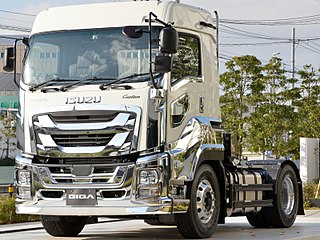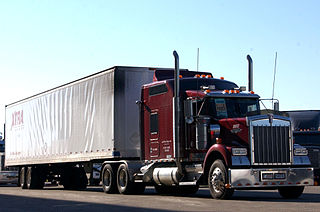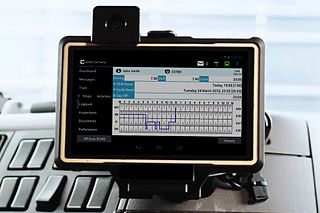
A truck sleeper or sleeper cab is a compartment attached behind the cabin of a tractor unit used for rest or sleeping. [1]

A truck sleeper or sleeper cab is a compartment attached behind the cabin of a tractor unit used for rest or sleeping. [1]

In many countries, drivers are subject to work-time regulations which limit the amount of time they can drive before taking a mandated minimum rest period. Many drivers chose to sleep in the cab or cabin of their trucks rather than pay for a roadside motel. Truck manufacturers took notice of this and began developing tractor units with extended cabs to provide a sleeping area for drivers. Work-time regulations apply in the United States, [2] Europe, [3] Australia [4] and in other parts of the world.

Sleeping berths came into use as early as the 1920s, but they were often unsafe and uncomfortable. [5] They nonetheless allowed owner-operators to spend months at a time on road, often driving in teams of two [6] (one drove while the other slept). [5] With this successful formula, drivers began making requests to truck manufacturers for larger and larger sleeping cabins. Manufacturers began catering to owner operators who requested greater luxury. Sleepers were initially developed without comfort in mind at 18 to 24 in (457 to 610 mm). They quickly grew to 36 to 48 in (914 to 1,219 mm) with long-haul drivers in mind. Their size came to be regulated in the US in the 1950s but length restrictions were removed in the 1980s. [5] Custom truck sleepers vary in size in modern trucks from 36 in (914 mm) to the massive 230 in (5,842 mm). Custom sleepers come equipped with many of the amenities of modern RVs. By 2000, approximately 70% of new trucks manufactured in the US included sleeper berths. [5]

A truck or lorry is a motor vehicle designed to transport freight, carry specialized payloads, or perform other utilitarian work. Trucks vary greatly in size, power, and configuration, but the vast majority feature body-on-frame construction, with a cabin that is independent of the payload portion of the vehicle. Smaller varieties may be mechanically similar to some automobiles. Commercial trucks can be very large and powerful and may be configured to be mounted with specialized equipment, such as in the case of refuse trucks, fire trucks, concrete mixers, and suction excavators. In American English, a commercial vehicle without a trailer or other articulation is formally a "straight truck" while one designed specifically to pull a trailer is not a truck but a "tractor".

A pickup truck or pickup is a light-duty truck that has an enclosed cabin, and a back end made up of a cargo bed that is enclosed by three low walls with no roof. In Australia and New Zealand, both pickups and coupé utilities are called utes, short for utility vehicle. In South Africa, people of all language groups use the term bakkie; a diminutive of Afrikaans: bak, meaning bowl or container.
Freightliner Trucks is a US semi truck manufacturer. Founded in 1929 as the truck-manufacturing division of Consolidated Freightways, the company was established in 1942 as Freightliner Corporation. Owned by Daimler AG from 1981 to 2021, Freightliner is now a part of Daimler Truck subsidiary Daimler Truck North America.

Kenworth Truck Company is an American truck manufacturer. Founded in 1923 as the successor to Gersix Motor Company, Kenworth specializes in production of heavy-duty and medium-duty commercial vehicles. Headquartered in the Seattle suburb of Kirkland, Washington, Kenworth has been a wholly owned subsidiary of PACCAR since 1945, operating alongside sister company Peterbilt Motors.

A truck driver is a person who earns a living as the driver of a truck, which is commonly defined as a large goods vehicle (LGV) or heavy goods vehicle (HGV).

The Autocar Company is an American specialist manufacturer of severe-duty, Class 7 and Class 8 vocational trucks, with its headquarters in Birmingham, Alabama. Started in 1897 in Pittsburgh, Pennsylvania, as a manufacturer of Brass Era automobiles, and trucks from 1899, Autocar is the oldest surviving motor vehicle brand in the Western Hemisphere.

The Mercedes-Benz Actros is a heavy-duty truck introduced by Mercedes-Benz at the 1996 Commercial Vehicle IAA in Hanover, Germany, as the replacement for the SK. It is normally used for long-distance haulage, heavy-duty distribution haulage, and construction haulage. It is powered by an inline-6 diesel engine with a turbocharger and intercooler. Daimler Trucks/Lorries launched version II of the Actros in 2002 and version III in 2007. The fourth generation of the Actros, officially named "the New Actros," launched in July 2011.

A tractor unit, also known as a truck unit, lorry unit, power unit, prime mover, ten-wheeler, semi-tractor, semi-truck, semi-lorry, tractor cab, truck cab, lorry cab, big rig tractor, big rig truck or big rig lorry or simply a tractor, truck, lorry, semi, big rig or rig, is a characteristically heavy-duty towing engine that provides motive power for hauling a towed or trailered load. These fall into two categories: heavy- and medium-duty military and commercial rear-wheel-drive semi-tractors used for hauling semi-trailers, and very heavy-duty typically off-road-capable, often 6×6, military and commercial tractor units, including ballast tractors.

Cab-over, also known as cab over engine (COE), cab forward or flat face (U.S.), flat nose (Canada), or forward control (UK), is a body style of truck, bus, or van that has a vertical front, "flat face" or a semi-hood, with the cab of the truck sitting above the front axle. This contrasts with a conventional truck where the engine is mounted in front of the driver.

The Isuzu Giga is a line of heavy-duty commercial vehicles produced by Isuzu since 1994. Outside Japan it is known as Isuzu C/E series. It was formally known as the Isuzu Heavy-Duty Truck'. Between 1994 and 2016, it was also sold in South America.

Towing is coupling two or more objects together so that they may be pulled by a designated power source or sources. The towing source may be a motorized land vehicle, vessel, animal, or human, and the load being anything that can be pulled. These may be joined by a chain, rope, bar, hitch, three-point, fifth wheel, coupling, drawbar, integrated platform, or other means of keeping the objects together while in motion.

Taxis in Australia are highly regulated by each Australian state and territory, with each state and territory having its own history and structure. In December 2014, there were 21,344 taxis in Australia. Taxis in Australia are required to be licensed and are typically required to operate and charge on a fitted taximeter. Taxi fare rates are set by State or Territory governments. A vehicle without a meter is generally not considered to be a taxi, and may be described, for example, as a hire car, limousine, carpool, etc. Most taxis today are fueled by liquid petroleum gas. A2B Australia owns and operates the Cabcharge payment system, which covers 98% of taxis in Australia, and operates one of Australia's largest taxi networks.

An articulated hauler, articulated dump truck (ADT), or sometimes a dump hauler, is a very large heavy-duty type of dump truck used to transport loads over rough terrain, and occasionally on public roads. The vehicle usually has all-wheel drive and consists of two basic units: the front section, generally called the tractor, and the rear section that contains the dump body, called the hauler or trailer section. Steering is made by pivoting the front in relation to the back by hydraulic rams. This way, all wheels follow the same path, making it an excellent off-road vehicle.

The Urals Automotive Plant, an Open Stock Company, is a major Russian manufacturer of off-road trucks under the Ural brand. Located in the city of Miass, Chelyabinsk Oblast in the Ural Mountains. The plant was established in 1941; when the ZiS truck plant was evacuated from Moscow during World War II.

Hours of service (HOS) regulations are issued by the Federal Motor Carrier Safety Administration (FMCSA) and govern the working hours of anyone operating a commercial motor vehicle (CMV) in the United States. These regulations apply to truck drivers, commercial and intercity bus drivers, and school bus drivers who operate CMVs. These rules limit the number of daily and weekly hours spent driving and working, and regulate the minimum amount of time drivers must spend resting between driving shifts. For intrastate commerce, the respective state's regulations apply.

The trucking industry serves the American economy by transporting large quantities of raw materials, works in process, and finished goods over land—typically from manufacturing plants to retail distribution centers. Trucks are also used in the construction industry, two of which require dump trucks and portable concrete mixers to move the large amounts of rocks, dirt, concrete, and other building materials used in construction. Trucks in America are responsible for the majority of freight movement over land and are tools in the manufacturing, transportation, and warehousing industries.

An electronic on-board recorder (EOBR) is an electronic device attached to a commercial motor vehicle, which is used to record the amount of time a vehicle is being driven. This is similar to the tachograph, and is the American equivalent of the digital tachograph used in Europe. Trucks in the European Union are required to have digital tachographs installed, and are securely monitored by government agencies. However, in Europe, the new digital tachograph which is considered secure, can be tricked with a round magnet placed by drivers over the connection to the transmission box. Usually they tie a rope to that magnet, and with a simple pull, the magnet will disengage and will show that the driver started moving about half an hour ago . The majority of carriers and drivers in the United States currently use paper-based log books. On January 31, 2011, the U.S. Federal Motor Carrier Safety Administration (FMCSA) proposed a rule requiring Electronic On-Board Recorders for interstate commercial truck and bus companies. The proposed rule covers interstate carriers that currently use log books to record driver's hours of service. The proposal would affect more than 500,000 carriers in the United States and carriers that currently use time cards would be exempt.
A specialized set of jargon describe the tools, equipment, and employment sectors used in the trucking industry in the United States. Some terms may be used within other English-speaking countries, or within the freight industry in general. For example, shore power is a term borrowed from shipping terminology, in which electrical power is transferred from shore to ship, instead of the ship relying upon idling its engines. Drawing power from land lines is more efficient than engine idling and eliminates localized air pollution. Another borrowed term is "landing gear", which refers to the legs which support the front end of a semi-trailer when it is not connected to a semi-truck. Some nicknames are obvious wordplay, such as "portable parking lot", in reference to a truck that carries automobiles.

A sleeping berth is a bed or sleeping accommodation on vehicles. Space accommodations have contributed to certain common design elements of berths.

Western Star Trucks Sales, Inc. is an American truck manufacturer headquartered in Portland, Oregon, and a subsidiary of Daimler Truck North America, which is an independent subsidiary of the multinational Daimler Truck. Western Star trucks are commonly sold at Freightliner dealerships.